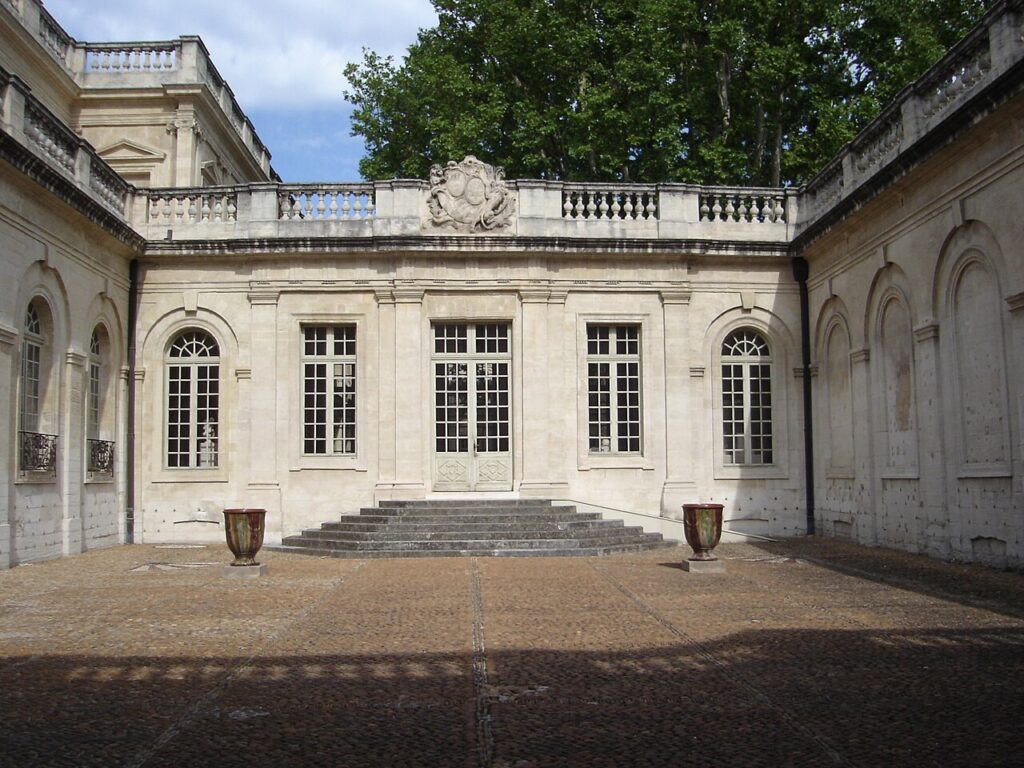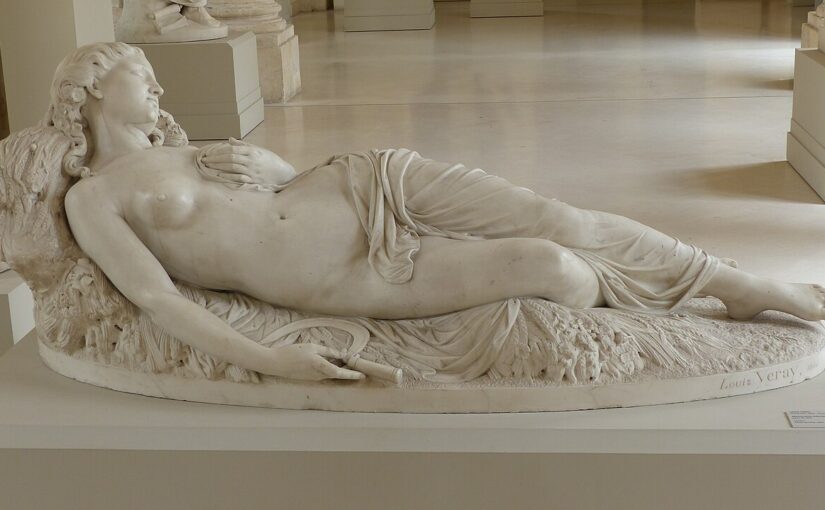Nestled in the historic heart of Avignon, the Musée Calvet stands as a beacon of culture and artistic heritage. It’s an essential destination for anyone eager to experience the rich tapestry of art, history, and craftsmanship that has shaped Provence, France, and the wider world. This museum, understated in its elegance yet powerfully compelling through its collections, offers much more than a simple gallery visit, it provides a journey through centuries of artistic achievement.
The Setting: Hôtel de Villeneuve-Martignan
The Musée Calvet is housed in the splendid Hôtel de Villeneuve-Martignan, an 18th-century mansion that is, in itself, a masterpiece of Provençal architecture. As you approach the museum on the bustling Rue Joseph Vernet, the building’s refined façade and intricate wrought-iron gates transport you to a time when Avignon was both a spiritual and economic powerhouse. The mansion’s transformation from a private residence to a public museum was a testament to the vision of local benefactor Esprit Calvet, whose passion for the arts laid the foundation for the institution’s enduring legacy.
Esprit Calvet: The Museum’s Philanthropic Founder
Esprit Calvet, a noted physician and collector, dedicated his life to the pursuit of knowledge and the appreciation of beauty. Upon his death in 1810, he bequeathed his impressive possessions, ranging from paintings and antiquities to a library and natural history cabinets, to the city of Avignon. His vision was realized thanks to an imperial decree, and the museum officially opened to the public in 1811. Over the centuries, Calvet’s original core collection has blossomed into one of southern France’s most diverse and respected art repositories.

An Encyclopedic Collection
The Musée Calvet lives up to its reputation as an encyclopedic museum, with holdings that seamlessly traverse epochs, styles, and continents. Its collections are divided mainly into fine arts, decorative arts, archaeology, and ethnography.
Fine Arts: Painting, Sculpture, and Masterworks
One of the museum’s greatest draws is its substantial fine arts collection, featuring a chronological progression from the Renaissance to modern masters. Here visitors encounter paintings from the 15th to the 20th centuries, with impressive representations from the French, Italian, Flemish, and Dutch schools. The gallery pays special tribute to artists connected to Avignon, notably the Mignard and Vernet families, whose evocative works offer insight into the region’s unique artistic narrative.
Masterpieces by renowned artists, including Corot, Manet, Sisley, and Géricault, adorn the museum walls. Works by Vlaminck and Soutine offer an expressive, modern counterpoint, while rare drawings by Cézanne and Modigliani, and paintings by Dufy and Utrillo, further establish the Musée Calvet as a serious destination for lovers of 19th and 20th-century art.
Sculpture lovers will also find much to admire, from classical statuary to more contemporary sculptures that capture the evolution of form and expression across generations.
Decorative Arts: From Tapestries to Orfèvrerie
The décor of the Hôtel de Villeneuve-Martignan provides a fitting backdrop for the decorative arts collections. Tapestries, porcelain, faience, bronzes, and goldsmith work dazzle in carefully curated rooms. Many of these pieces reveal the luxurious lifestyles of Avignon’s elite in centuries past, while also chronicling everyday objects whose delicate artistry elevates them to treasured status.
Furniture donated by prominent citizens, as well as memorable ensembles from gracious homes, provide an intimate glimpse into historic domestic life.
Archaeology: Echoes of Distant Civilizations
A walk through the museum reveals another of its crowning glories: its archaeological collections. Ranging from Ancient Egypt to Roman Gaul, these artifacts encompass a breathtaking array of cultures and periods. In three rooms dedicated to Egyptian antiquities, visitors can marvel at canopic vases, funerary medallions, and statues that speak to the mysteries and rituals of the Nile Valley. Greek and Gallo-Roman objects round out a collection that bridges the Mediterranean world with local Provençal history.
Ethnography: Artistic Dialogues Beyond Europe
Reflecting the far-reaching curiosity of its founders and subsequent benefactors, the Musée Calvet also boasts significant ethnographic holdings. Art and artifacts from Asia, Oceania, and Africa make this museum an invaluable crossroads of global dialogue, highlighting the connections that have long existed between Provence and lands far beyond.
The Musée Lapidaire: A Second Home for Antiquities
In the 1980s, the archaeological collections outgrew the confines of the main museum and found a spacious new setting in the nearby Musée Lapidaire. Housed in a former Jesuit chapel on Rue de la République, the Lapidaire now holds a treasure trove of ancient statuary, reliefs, and tombs. Notable pieces such as the Tarasque de Noves and impressive Celtic and Roman sculptures make it a must-see complement to the main museum, ideal for visitors fascinated by ancient civilizations.
The Museum Experience: Free Entry, Timeless Inspiration
One of the remarkable aspects of the Musée Calvet is its commitment to accessibility. Entry is free for all visitors, regardless of residency or nationality. This reflects both a civic philosophy and Calvet’s original intent: to open the doors of art and culture to the broadest possible audience.
Inside, the experience is both contemplative and engaging. Each room is arranged with an eye for storytelling, allowing pieces to communicate across centuries and genres. The beautiful garden, recently restored to its 18th-century layout, offers a tranquil setting to pause and reflect amid fragrant plants and classical statuary.
Family-friendly activities, guided tours, and temporary exhibitions provide additional ways to engage with the museum’s offerings throughout the year. Highlights have included efforts to restitute or research art works spoliated during World War II, as well as exhibitions by contemporary artists, demonstrating the museum’s dynamic approach to art’s evolving story.
A Living Heritage: The Calvet Foundation
Behind the scenes, the Fondation Calvet supports not only the museum and its satellite, the Lapidaire, but also several other key cultural institutions in Avignon and surrounding towns. This network ensures the careful stewardship of an extraordinary array of manuscripts, artifacts, and natural history specimens. The original library collection, now housed in the Bibliothèque Ceccano, remains a vital scholarly resource, continuing Esprit Calvet’s legacy of learning for future generations.
Practical Information
The Musée Calvet is centrally located at 65 Rue Joseph Vernet, making it easily accessible for tourists and locals alike. Opening hours vary by season, and visitors are encouraged to check the current schedule before planning their trip. The location in the heart of Avignon’s historic center means that a visit to the museum can be combined with a stroll through vibrant city streets, charming cafés, and other landmarks such as the Palais des Papes and Pont d’Avignon.
Why Visit the Musée Calvet?
For aficionados of art, history, and culture, the Musée Calvet is an essential stopping point on any visit to Avignon. But even for the casual visitor, the museum offers simple, powerful pleasures: the serenity of its galleries, the stories told through brushstroke, fabric, or carved stone, and the pleasure of stepping into a living legacy that has inspired thousands for generations. More than just a museum, it is a celebration of generosity, curiosity, and the enduring power of human creativity.
“Endormie” by Louis Veray
“Endormie”, also known as La Moissonneuse endormie (Sleeping Harvester), is a celebrated marble sculpture created in 1855 by the French sculptor Louis Veray. Housed in the Musée Calvet in Avignon, this artwork stands as a prime example of 19th-century French sculpture and Veray’s mastery of classical and naturalistic forms.
Louis Veray (1820–1891) was a prominent sculptor from Provence, trained under Henri Lehmann and Joseph Lacroix. He regularly exhibited at the Salon des artistes français from 1853 to 1884 and quickly gained recognition for his sensitive, realistic approach to figurative art. “Endormie” was first shown in plaster at the Salon, where it was awarded a third-class medal, and the finished marble version was presented at the Exposition Universelle in Paris in 1855.
Description and Interpretation
The sculpture depicts a sleeping young harvester, draped in rural clothing, resting peacefully after laboring in the fields. Carved from marble, the statue measures approximately 65 cm in height and 165 cm in length, lending it a life-size, impactful presence1. Veray’s skill is evident in the lifelike representation of the reclining figure, the softness of her limbs, the gentle contours of her face, and the relaxed posture all evoke a deep sense of tranquility and well-deserved repose.
“Endormie” resonates as both a celebration of rural life and a homage to the dignity of labor. The harvester’s serene state invites viewers to contemplate the simple joys and vulnerabilities of peasant life, themes that were particularly poignant during a period of widespread social change in France.
Today, “Endormie” remains one of the highlights of the Musée Calvet’s collection, admired for its technical finesse and moving humanity. The sculpture demonstrates Veray’s talent and empathy and secures his reputation among the accomplished sculptors of the 19th century.
Header image by Finoskov.
If our work has inspired you, helped you grow, or simply brought a little warmth to your day, consider supporting Thalysia.com with a small donation. Your contribution helps us continue exploring ancient landscapes, documenting local traditions, and celebrating the art of living well.
